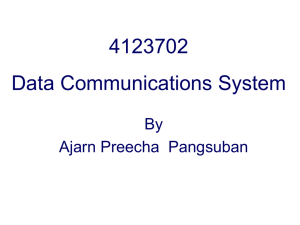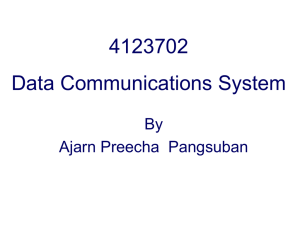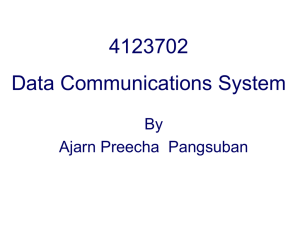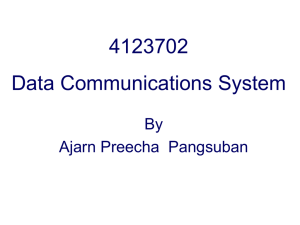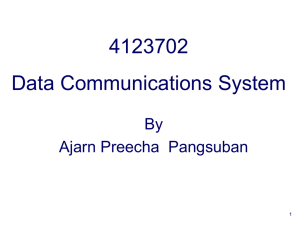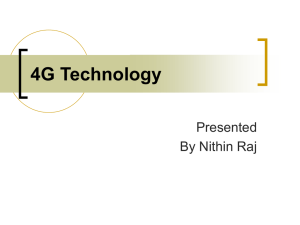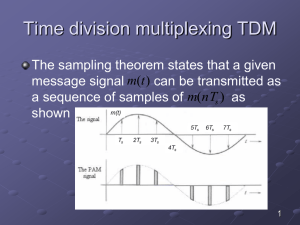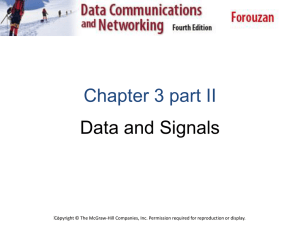ch3-Physical Layer
advertisement
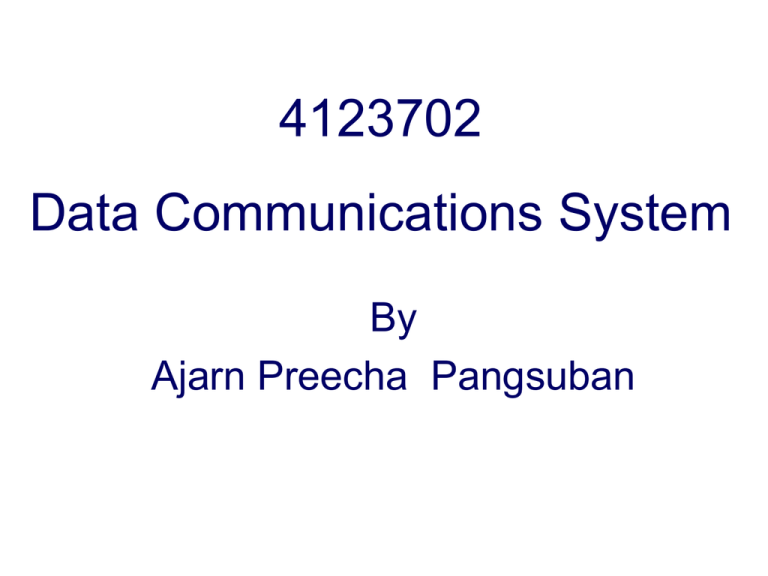
4123702 Data Communications System By Ajarn Preecha Pangsuban Part 2 – Physical Layer Interacts with transmission media Creates a signal representing 0s and 1s Physical movement of data Determines direction of data flow Decides on the number of logical channels for transporting data coming from different source Coming up… 4123702 Data Communications System @YRU 2 Position of the physical Layer 4123702 Data Communications System @YRU 3 Physical layer services 4123702 Data Communications System @YRU 4 Transmission Media Guided Twisted-pair Coaxial cable Fiber-optic Unguided Radio Microwave 4123702 Data Communications System @YRU 5 Networks and Technologies Telephone network – circuit-switched network High speed access Modems DSL Cable 4123702 Data Communications System @YRU 6 Part 2 Chapters Chapter 3 Signals Chapter 4 Digital Transmission Chapter 5 Analog Transmission Chapter 6 Multiplexing Chapter 7 Transmission Media Chapter 8 Circuit Switching and Telephone Network Chapter 9 High Speed Digital Access 4123702 Data Communications System @YRU 7 Chapter 3: Signals 4123702 Data Communications System @YRU 8 Note: To be transmitted, data must be transformed to electromagnetic signals. 4123702 Data Communications System @YRU 9 Analog and Digital Signals Signals can be analog or digital form Analog signals can have an infinite number of values in a range digital signals can have only a limited number of values. 4123702 Data Communications System @YRU 10 Periodic and Aperiodic Signals Periodic – completes a pattern within a measurable time frame, called a period One full pattern is a cycle Analog signals Aperiodic – changes without exhibiting a pattern Digital signals 4123702 Data Communications System @YRU 11 Periodic Signals 4123702 Data Communications System @YRU 12 Aperiodic Signals 4123702 Data Communications System @YRU 13 Note: In data communication, we commonly use periodic analog signals and aperiodic digital signals. 4123702 Data Communications System @YRU 14 Analog Signals Sine wave – most fundamental form of a periodic analog signal Fully described by: Amplitude, Frequency and Phase 4123702 Data Communications System @YRU 15 Analog Signaling More susceptible to noise and less precise than a digital signal Benefit - because they are more variable than digital signals, they can convey greater subtleties 4123702 Data Communications System @YRU 16 Amplitude Absolute value of a signal’s highest intensity Normally measured in volts 4123702 Data Communications System @YRU 17 Period and Frequency Period - amount of time to complete one cycle, expressed in seconds (s) Frequency – number of periods in one second, inverse of period 4123702 Data Communications System @YRU 18 Frequency Rate of change with respect to time, expressed in hertz (Hz) Change in a short span of time means high frequency Change over a long span of time means low frequency 4123702 Data Communications System @YRU 19 Phase Position of the waveform relative to time zero Measured in degrees or radians 4123702 Data Communications System @YRU 20 Table 3.1 Units of periods and frequencies Unit Seconds (s) Equivalent 1s Unit hertz (Hz) Equivalent 1 Hz Milliseconds (ms) 10–3 s kilohertz (KHz) 103 Hz Microseconds (ms) 10–6 s megahertz (MHz) 106 Hz Nanoseconds (ns) 10–9 s gigahertz (GHz) 109 Hz Picoseconds (ps) 10–12 s terahertz (THz) 1012 Hz 4123702 Data Communications System @YRU 21 Example Sine Waves s(t) = A sin(2ft +) 4123702 Data Communications System @YRU 22 Example 1 Express a period of 100 ms in microseconds, and express the corresponding frequency in kilohertz. Solution From Table 3.1 we find the equivalent of 1 ms.We make the following substitutions: 100 ms = 100 10-3 s = 100 10-3 106 ms = 105 ms Now we use the inverse relationship to find the frequency, changing hertz to kilohertz 100 ms = 100 10-3 s = 10-1 s f = 1/10-1 Hz = 10 10-3 KHz = 10-2 KHz 4123702 Data Communications System @YRU 23 Example 2 A sine wave is offset one-sixth of a cycle with respect to time zero. What is its phase in degrees and radians? Solution We know that one complete cycle is 360 degrees. Therefore, 1/6 cycle is (1/6) 360 = 60 degrees = 60 x 2 /360 rad = 1.046 rad 4123702 Data Communications System @YRU 24 Time and Frequency Domains Time-domain plot – displays changes in signal amplitude with respect to time Frequency-domain plot – relationship between amplitude and frequency Best represents an analog signal 4123702 Data Communications System @YRU 25 Figure 3.6 Sine wave examples 4123702 Data Communications System @YRU 26 Figure 3.6 Sine wave examples (cont.) 4123702 Data Communications System @YRU 27 Figure 3.6 Sine wave examples (cont.) 4123702 Data Communications System @YRU 28 Figure 3.7 Time and frequency domains 4123702 Data Communications System @YRU 29 Figure 3.7 Time and frequency domains (cont.) 4123702 Data Communications System @YRU 30 Figure 3.7 Time and frequency domains (cont.) 4123702 Data Communications System @YRU 31 Composite Signals Composed of many simple sine waves of differing frequencies Fourier – showed any composite signal is a sum of a set of sine waves of different frequencies, phases, and amplitudes (Harmonics) Fourier analysis sin(2kft) s(t ) A k odd ,k 1 k 4 Harmonics – components of digital signal, each having a different frequencies, phases, and amplitudes 4123702 Data Communications System @YRU 32 Figure 3.8 Square wave 4A 4A 4A s(t ) sin 2ft sin[ 2 (3 f )t ] sin[ 2 (5 f )t ] ... 3 5 4123702 Data Communications System @YRU 33 Figure 3.9 Three harmonics 4123702 Data Communications System @YRU 34 Figure 3.10 Adding first three harmonics 4123702 Data Communications System @YRU 35 Frequency Spectrum Description of a signal using the frequency domain and containing all of its components Dependent on medium used 4123702 Data Communications System @YRU 36 Figure 3.11 Frequency spectrum comparison 4123702 Data Communications System @YRU 37 Composite Signals and Transmission Medium A medium’s characteristics may affect the signal Some frequencies may be weakened or blocked Signal corruption – when square wave is sent through a medium, other end which is not square wave at all Figure 3.12 Signal corruption 4123702 Data Communications System @YRU 38 Bandwidth Range of frequencies that a medium can pass without losing one-half of the power contained in the signal Difference between the highest and the lowest frequencies that the medium can satisfactorily pass. In this book, we use the term bandwidth to refer to the property of a medium or the width of a single spectrum. 4123702 Data Communications System @YRU 39 Figure 3.13 Bandwidth 4123702 Data Communications System @YRU 40 Frequency Spectrum 4123702 Data Communications System @YRU 41 Example 3 If a periodic signal is decomposed into five sine waves with frequencies of 100, 300, 500, 700, and 900 Hz, what is the bandwidth? Draw the spectrum, assuming all components have a maximum amplitude of 10 V. Solution B = fh - fl = 900 - 100 = 800 Hz The spectrum has only five spikes, at 100, 300, 500, 700, and 900 (see Figure 13.4 ) 4123702 Data Communications System @YRU 42 Figure 3.14 Example 3 4123702 Data Communications System @YRU 43 Example 4 A signal has a bandwidth of 20 Hz. The highest frequency is 60 Hz. What is the lowest frequency? Draw the spectrum if the signal contains all integral frequencies of the same amplitude. Solution B = fh - fl 20 = 60 - fl fl = 60 - 20 = 40 Hz 4123702 Data Communications System @YRU 44 Figure 3.15 Example 4 4123702 Data Communications System @YRU 45 Example 5 A signal has a spectrum with frequencies between 1000 and 2000 Hz (bandwidth of 1000 Hz). A medium can pass frequencies from 3000 to 4000 Hz (a bandwidth of 1000 Hz). Can this signal faithfully pass through this medium? Solution The answer is definitely no. Although the signal can have the same bandwidth (1000 Hz), the range does not overlap. The medium can only pass the frequencies between 3000 and 4000 Hz; the signal is totally lost. 4123702 Data Communications System @YRU 46 Quiz In this picture, what is the bandwidth? when f=1MHz 4123702 Data Communications System @YRU 47 Digital Signals Use binary (0s and 1s) to encode information Usually aperiodic; period and frequency are not appropriate Less affected by interference (noise); fewer errors 4123702 Data Communications System @YRU 48 Figure 3.16 A digital signal 4123702 Data Communications System @YRU 49 Bit Interval and Bit Rate Describe digital signals by Bit interval – time required to send one single bit Bit rate – number of bit intervals per second, usually expressed as bits per second (bps) Figure 3.17 Bit rate and bit interval 4123702 Data Communications System @YRU 50 Example 6 A digital signal has a bit rate of 2000 bps. What is the duration of each bit (bit interval) Solution The bit interval is the inverse of the bit rate. Bit interval = 1/ 2000 s = 0.000500 s = 0.000500 x 106 ms = 500 ms 4123702 Data Communications System @YRU 51 Digital signal As a Composite Analog Signal A composite analog signal having an infinite number of frequency The bandwidth of a digital signal is infinite A digital signal is a composite signal with an infinite bandwidth. 4123702 Data Communications System @YRU 52 Digital signal through a wide bandwidth medium Some of frequencies are blocked by medium But still enough are passed to preserve a decent signal shape Such as a coaxial cable to send a digital through a LAN 4123702 Data Communications System @YRU 53 Digital signal through a band-limited medium Can send digital data through a band-limited medium ? Yes / No Such as the Internet via telephone line The relationship between bite rate (n) and the required bandwidth (B) n B Using only one harmonic 2 Using more harmonic 4123702 Data Communications System @YRU n B or n 2 B 2 54 Using only one harmonic (Digital versus Analog) 4123702 Data Communications System @YRU 55 Using more harmonic Third harmonic n 3n 4n B 2 2 2 Fifth harmonic n 3n 5n 9n B 2 2 2 2 Bit Rate Harmonic 1 Harmonics 1, 3 Harmonics 1, 3, 5 Harmonics 1, 3, 5, 7 1 Kbps 500 Hz 2 KHz 4.5 KHz 8 KHz 10 Kbps 5 KHz 20 KHz 45 KHz 80 KHz 100 Kbps 50 KHz 200 KHz 450 KHz 800 KHz 4123702 Data Communications System @YRU 56 Note: The bit rate and the bandwidth are proportional to each other. 4123702 Data Communications System @YRU 57 Digital versus Analog Bandwidth Analog bandwidth – range of frequencies a medium can pass; expressed in hertz Digital bandwidth – maximum bit rate that a medium can pass; expressed in bits per second (bps) 4123702 Data Communications System @YRU 58 Low-pass versus Band-pass Channels Channel or a link is either low-pass or band pass Low-pass –frequencies between 0 and f (infinity) Dedicated connections; alternating communications Digital transmissions Band-pass – frequencies between f1 and f2 Shared connections Analog transmissions 4123702 Data Communications System @YRU 59 Data Rate Limits Dependent on three factors Bandwidth available Levels of signals we can use Quality of the channel (level of noise) 4123702 Data Communications System @YRU 60 Noiseless Channel: Nyquist Bit Rate Defines the theoretical maximum bit rate Bit Rate = 2 Bandwidth log2 L L is the number of signal levels used to represent data Consider a noiseless channel with a bandwidth of 3000 Hz transmitting a signal with two signal levels. The maximum bit rate can be calculated as Bit Rate = 2 3000 log2 2 = 6000 bps 4123702 Data Communications System @YRU 61 Noisy Channel: Shannon Capacity Determine the theoretical highest data rate for a noisy channel Capacity = Bandwidth log2 (1 + SNR) We can calculate the theoretical highest bit rate of a regular telephone line. A telephone line normally has a bandwidth of 3000 Hz (300 Hz to 3300 Hz). The signal-to-noise ratio is usually 3162. For this channel the capacity is calculated as C = B log2 (1 + SNR) = 3000 log2 (1 + 3162) = 3000 log2 (3163) C = 3000 11.62 = 34,860 bps 4123702 Data Communications System @YRU 62 Transmission Impairment Imperfections cause impairment 4123702 Data Communications System @YRU 63 Attenuation Loss of energy Amplifiers are used to strengthen 4123702 Data Communications System @YRU 64 Decibel Measures the relative strength of two signals or a signal at two different points dB = 10 log 10 (P2/P1) Imagine a signal travels through a transmission medium and its power is reduced to half. This means that P2 = 1/2 P1. In this case, the attenuation (loss of power) can be calculated as 10 log10 (P2/P1) = 10 log10 (0.5P1/P1) = 10 log10 (0.5) = 10(–0.3) = –3 dB 4123702 Data Communications System @YRU 65 Distortion Signal changes form or shape Each component has its own propagation speed, therefore its own delay in arriving 4123702 Data Communications System @YRU 66 Noise Corruption caused by Thermal noise – random motion of electrons, creating an extra signal Induced noise – outside sources such as motors and appliances Crosstalk – effect of one wire on another Impulse noise – a spike for a short period from power lines, lightning, etc. 4123702 Data Communications System @YRU 67 Noise 4123702 Data Communications System @YRU 68 More About Signals Throughput - how fast data can pass through an entity (such as a point or network) 4123702 Data Communications System @YRU 69 More About Signals Propagation speed – distance a signal or bit can travel through a medium in one second depend on Medium Frequency 4123702 Data Communications System @YRU 70 More About Signals Propagation time – time required for a signal (or bit) to travel from one point of the transmission to another Propagation time = Distance/Propagation speed 4123702 Data Communications System @YRU 71 More About Signals (cont) Wavelength – distance a simple signal can travel in one period Depends on both the frequency and the medium Wavelength = Propagation speed x Period 4123702 Data Communications System @YRU 72 Next… How do we transform data into signals to send them to our destination? Encoding – converting to digital Modulation – converting to analog 4123702 Data Communications System @YRU 73 Credits All figures obtained from publisher-provided instructor downloads Data Communications and Networking, 3rd edition by Behrouz A. Forouzan. McGraw Hill Publishing, 2004 4123702 Data Communications System @YRU 74
